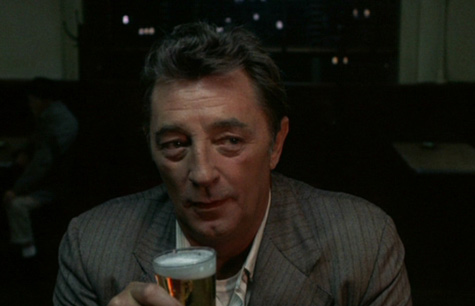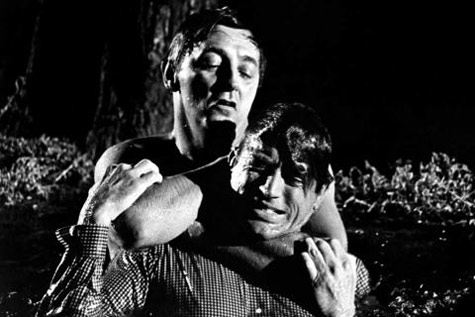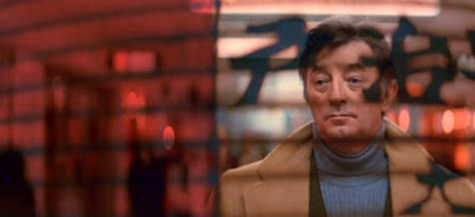
Yesterday in Part I we looked at Robert Mitchum’s film career from the 1940s to the 1960s.
The 1960s were a terrible time for the movie business. The golden era had come to an end. The studio system had been destroyed, and television was ascendant. The great moguls and stars who had created Hollywood and pushed it to its heights were dead or dying.
Like everything else in this period, film noir faced existential challenges. The bedrock of the noir visual style, glorious black and white, gave way to color. The B-movie production machine—at least the machine as most people had known it—died with the major studios. And the stars had scattered. Bogart was dead. So were Frank Lovejoy and John Hodiak. Sterling Hayden fled the country with his children. And Lizabeth Scott—maybe the greatest of all noir goddesses—had retreated to her seclusion.
The only one who seemed to still be standing was the king himself. Robert Mitchum emerged from the 1950s as a big star—hell, maybe bigger than he had been going in.
Other stars were still around (Barbara Stanwyck, John Payne, Dana Andrews) but they were diminished, relegated to television or supporting roles. Mitchum was still Mitchum. Like John Wayne (though not to the same degree), he seemed to grow in stature as the years went on. Even after the classic era of noir had come to an end, Mitchum endured—and endured not as some old holdover, but as the living embodiment of the ethos of the thing. As the ’60s gave way to the ’70s, he seemed more and more like the walking symbol of film noir.
There were plenty of missteps along the way, of course. Bad movies, indifferent performances. Booze and cigarettes and weed and women all took their toll. And because only the establishment will pay you millions of dollars for playing antiheroes, no antihero lives in a mansion without being full of shit. Eventually, like everyone else, he got old.
But in his middle years, and going into the winter of his life, the king kept doing great work. He provided the strongest link from the classic era of noir to the neo-noir era that eventually succeeded it. When he died—on the same day as Jimmy Stewart, coincidentally—it was not as if an era had passed, because for longer than most movie stars, Mitchum had seemed to stand outside of eras. In his importance to cinema, he transcended any decade. That’s an icon. That’s the king.
Essential Late Career Mitchum:
1. Cape Fear (1962): You can practically see the transition between classic and neo-noir take place as Mitchum plays Max Cady, a rapist out to get revenge on the defense lawyer who betrayed him. If you are only used to seeing him as noir’s great antihero, it will be jarring to witness Mitchum’s unflinching embodiment of Max Cady.

2. The Friends Of Eddie Coyle (1973): Peter Yates’s faithful adaptation of the great George V. Higgins novel is really an ensemble drama about working stiffs who just happen to be criminals. One of the key films of the 1970s, its cast is a virtual who’s who of the great character actors of the period: Peter Boyle, Richard Jordan, Steven Keats, Alex Rocco, Joe Santos. At its center is Mitchum, playing an aging hood just trying to keep himself from going to jail for a two-year stretch, and his performance is a thing of beauty. Without ever trying to hog the spotlight (he really is just another member of the ensemble), he gives the movie its weary, battered heart. Gone is the glamour of the classic era. In its place are desperate people trying to negotiate their fate in a society that seems to be crumbling around them.

4. Farewell My Lovely (1975): Mitchum finally got around to playing hardboiled fiction’s most famous detective, Philip Marlowe, in this retro-noir from director Dick Richards. In a craggy voiceover, Mitchum sets the scene, “This past spring was the first that I felt tired and realized I was growing old. Maybe it was the rotten weather we’d had in L.A. Maybe the rotten cases I’d had… Or maybe it was just the plain fact that I am tired and growing old.” If it’s not as deep or as great as the similar Chinatown, it’s probably truer to the pulpy origins of the genre. It’s trashier, and I mean that in a good way. Mitchum—in his last great noir role—is perfect. Roger Ebert called this the actor’s “definitive performance” and if I wouldn’t go that far, I would say that Mitchum is so fully possessed here it’s almost as if he’s always been Marlowe his whole life. In a sense, maybe he had.
5. A Killer In The Family (1983): Okay, this one is not essential, but it is interesting. Mitchum plays a convict who convinces his three sons (James Spader, Eric Stolz, Lance Kerwin) to bust him out of jail, along with his nutjob cellmate (Stuart Margolin). Written by Sue Grafton (who had just published her first Kinsey Millhone mystery) and her then husband Steven Humphrey, Killer looks and feels every bit like the 1980s made-for-TV movie that it is. But among Mitchum’s television work in the ’80s (The Winds of War, War and Remembrance, North and South) this film alone uses his iconic status to make him a full-on villain. He’s a larger-than-life figure for his sons, and that is the root of the problem for them. They soon discover that Dad is closer to the Mitchum of Cape Fear and The Night of the Hunter than the grand old man they thought he was.
Jake Hinkson, the Night Editor, is the author of The Posthumous Man.
Read all posts by Jake Hinkson for Criminal Element.

Wonderful wrap up of an excellent career, and it was terrific to see him one last time as a really, really bad guy in A Killer in the Family. As with Mr. Allison, I did adore him in The Winds of War, War and Remembrance, and North and South. It was always easier to adore him when his roles were not “toughest guy on the screen.” As a tough guy he usually scared me.
Great list, especially since it included the under-valued ‘The Yakuza’.